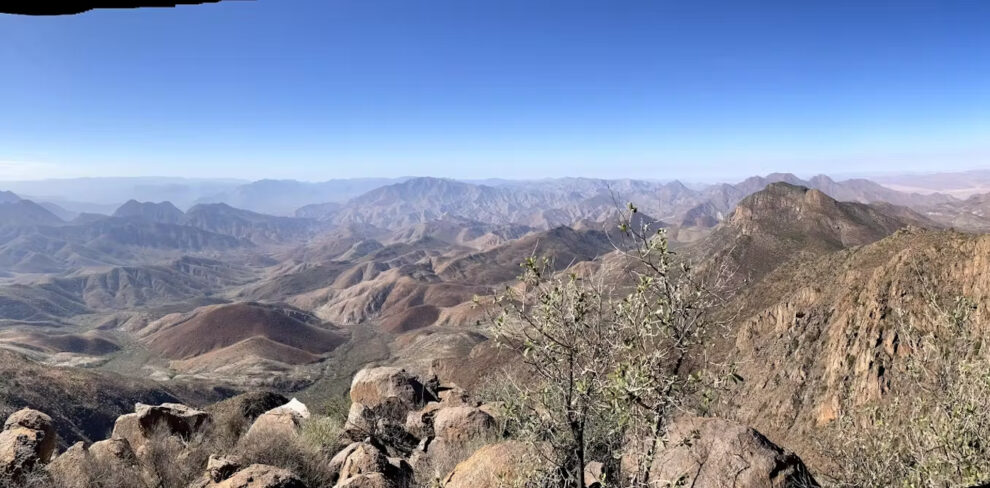The Kaokoveld region, covering north-western Namibia and south-western Angola, is one of the remotest areas in southern Africa. Although it’s extremely dry, it is a center of species endemism: many species occur only there and nowhere else on earth.
New species continue to be found, especially in the Ovahimba mountain range, which runs parallel to the cold Atlantic ocean and is separated from it by the gravel plains and dunes of the northern Namib Desert.
The highest mountain peaks of this range are so inhospitable and difficult to access, because of the lack of roads and water, that few have ever scaled them. The exceptions are local herders of the semi-nomadic Himba, who drive their cattle and goats to richer pastures in the mountains during dry periods.
In 2021, I was part of a team of researchers from Namibia and Angola who aimed to investigate the biodiversity and endemism on some of the most remote peaks. We hypothesized that the mountain peaks harbored a large number of species, especially plants, insects and reptiles. That’s because there’s a rapid change in climate and topography (land features) from the hyper-arid, cool desert near the coast and the arid and seasonally warmer plains further inland to the cooler mountainous escarpment.
Through an EU-funded transfrontier conservation project, SCIONA, we had the opportunity to use the only safe option to get to the Ovahimba mountain peaks: a helicopter.
It is incredibly exciting to plan a trip to such a remote and beautiful wilderness area where few people have intervened in the ecosystem.
Because of the high cost and complicated logistics, we had to limit the visit to a few days on each of three mountain tops. Two were in Angola—Serra Cafema and Serra Tchamalindi in Iona National Park—and one was in the Otjihipa range of Namibia. The mountain tops were selected based on their altitude and remoteness. They also have many ecological niches based on exposure to wind and sun.
At each campsite, we left excitedly in different directions, to return and exchange findings and stories after sunset.
Even in this short visit, we found plenty of interest and some surprises. Of the 285 plant species we encountered, 34 species are endemic to the Kaokoveld. One is new to science and at least six endemics fall in the endangered IUCN red list category. Sixteen plant species that were previously known only from Namibia were found in Angola. We also recorded two bird species, the Cape Eagle Owl and Layard’s Warbler, in Angola for the first time.
These mountain flora deserve priority conservation efforts to protect endemic and other plants that have survived in these refuge sites, providing a habitat for some unique fauna.
Helicopter adventure
Our helicopter hops between the mountains gave us unforgettable, magnificent views of the mountains, through which the glittering Kunene River meanders. The first campsite was in the Otjihipa range, at a mountain that we named Middelberg (1,941 meters above sea level).
The ridge boasts a diverse shrub and woodland vegetation, unlike the barren plains surrounding it, because of the cooler temperatures, the water bearing capacities of rocks, less grazing and browsing, and what we assume is higher rainfall (there are no records). It was adorned by beautiful Kaoko tree-euphorbias (Euphorbia eduardoi).
We also found a large underground cave with intact stalactite and stalagmite formations. This is unusual in the area and may indicate that there was much more water there in the past.
The second campsite was near a mountain top in the eastern part of the large Tchamalinde range, at an elevation of 1,420 meters above sea level. The helicopter could not land higher up the mountain where it was covered with a continuous tree layer. The Kaokoveld endemic flower Turnera oculata var. paucipilosa thrives in this area, as well as the resurrection bush (Myrothamnus flabellifolius) and the black stick lily (Xerophyta retinervis). Resurrection plants appear to be dead during the dry season but suddenly turn green with the rains.
Our last campsite was 100 meters from the top of the highest mountain of Iona National Park, Serra Cafema (2,050 meters above sea level). Of the three mountain tops we visited, it was the closest to the coast (85km) and therefore also the coldest and windiest.
Despite the harsh climate, there was a surprising amount of vegetation, mainly a mosaic of hardy Cape fynbos-like shrubs and dry savanna vegetation with large-stemmed Namib resin trees (Ozoroa crassinervia). It was a surprise to find the tall Euphorbia monteiroi subsp. brandbergensis as it was previously only known further south in Namibia. Another beautiful Turnera flower (Turnera oculata var. oculata) was common at Serra Cafema, as well as large specimens of mother-in-law’s-tongue (Sansevieria pearsonii).
Even on the mountain top of Serra Cafema, the highest and remotest of all, there were signs of human impact via grazing.
The findings show the highest plant biodiversity on Serra Cafema, with 56 species per 1,000m² compared to 47 species per 1,000m² for the other mountains. Of the three mountains, Serra Cafema is the most influenced by fog caused by the cold Benguela current. Species composition is very different from the surrounding lowlands.
Protecting biodiversity
We unlocked only a fraction of the mystery held by these biodiversity hotspots. There is no doubt that yet more unusual and interesting plants and animals are waiting to be discovered on these inaccessible peaks, especially because our visit took place after 10 years of drought. Huge swarms of locusts were in the barren plains at that time.
However, our reconnaissance survey did show that the plants here need protection. They are threatened by climate change and overgrazing by livestock. Management of the Ovahimba highlands is in the hands of Namibian communal conservancies, the NGO African Parks and the Namibian and Angolan governments. African Parks recently took over management of Iona National Park, which may offer opportunities to protect the mountain habitats.
Source : PHYS
















